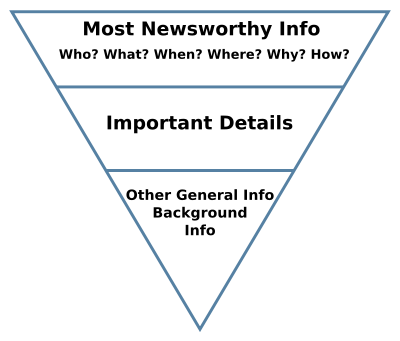
Back هرم مقلوب Arabic Tərs piramida Azerbaijani Обърната пирамида Bulgarian Nyhedstrekanten Danish Prinzip der umgekehrten Pyramide German Piramida stilo Esperanto Pirámide invertida Spanish هرم وارونه Persian Pyramide inversée (journalisme) French פירמידה הפוכה (תקשורת) HE

The inverted pyramid is a metaphor used by journalists and other writers to illustrate how information should be prioritised and structured in prose (e.g., a news report). It is a common method for writing news stories and has wide adaptability to other kinds of texts, such as blogs, editorial columns and marketing factsheets. It is a way to communicate the basics about a topic in the initial sentences. The inverted pyramid is taught to mass communication and journalism students, and is systematically used in English-language media.[1]
The inverted or upside-down pyramid can be thought of as a triangle pointing down. The widest part at the top represents the most substantial, interesting, and important information that the writer means to convey, illustrating that this kind of material should head the article, while the tapering lower portion illustrates that other material should follow in order of diminishing importance.
It is sometimes called a summary news lead style,[2] or bottom line up front (BLUF).[3] The opposite, the failure to mention the most important, interesting or attention-grabbing elements of a story in the opening paragraphs, is called burying the lede.
- ^ "Lesson 11: Structuring news reports". The Guardian. Retrieved 11 November 2021.
The structure and layout of a news report is important as it ensures that readers can find the most important information quickly
- ^ Cite error: The named reference
erricowas invoked but never defined (see the help page). - ^ "Being Direct 1: Martin Krieger's 'Bottom Line Up Front' - writingmatterssite". sites.google.com. Retrieved Apr 28, 2020.
© MMXXIII Rich X Search. We shall prevail. All rights reserved. Rich X Search